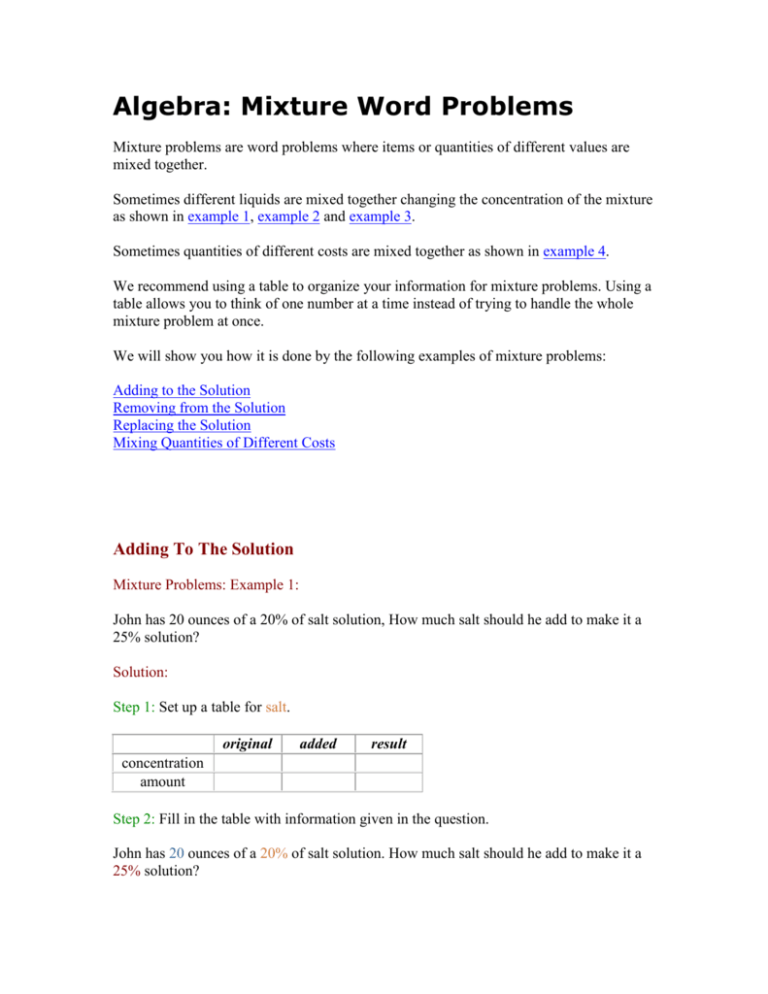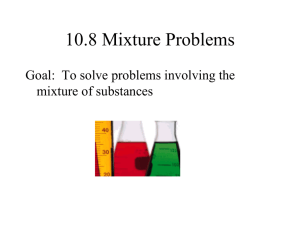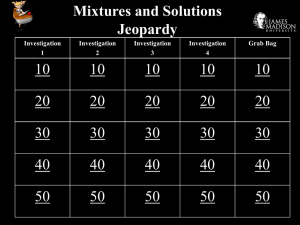Algebra: Mixture Word Problems
advertisement

Algebra: Mixture Word Problems Mixture problems are word problems where items or quantities of different values are mixed together. Sometimes different liquids are mixed together changing the concentration of the mixture as shown in example 1, example 2 and example 3. Sometimes quantities of different costs are mixed together as shown in example 4. We recommend using a table to organize your information for mixture problems. Using a table allows you to think of one number at a time instead of trying to handle the whole mixture problem at once. We will show you how it is done by the following examples of mixture problems: Adding to the Solution Removing from the Solution Replacing the Solution Mixing Quantities of Different Costs Adding To The Solution Mixture Problems: Example 1: John has 20 ounces of a 20% of salt solution, How much salt should he add to make it a 25% solution? Solution: Step 1: Set up a table for salt. original added result concentration amount Step 2: Fill in the table with information given in the question. John has 20 ounces of a 20% of salt solution. How much salt should he add to make it a 25% solution? The salt added is 100% salt, which is 1 in decimal. Change all the percent to decimals Let x = amount of salt added. The result would be 20 + x. concentration amount original 0.2 20 added 1 x result 0.25 20 + x Step 3: Multiply down each column. concentration amount multiply original 0.2 20 0.2 × 20 added 1 x 1×x result 0.25 20 + x 0.25(20 + x) Step 4: original + added = result 0.2 × 20 + 1 × x = 0.25(20 + x) 4 + x = 5 + 0.25x Isolate variable x x – 0.25x = 5 – 4 0.75x = 1 Answer: He should add ounces of salt. Removing From The Solution Mixture Problems: Example 2: John has 20 ounces of a 20% of salt solution. How much water should he evaporate to make it a 30% solution? Solution: Step 1: Set up a table for water. The water is removed from the original. original removed result concentration amount Step 2: Fill in the table with information given in the question. John has 20 ounces of a 20% of salt solution. How much water should he evaporate to make it a 30% solution? The original concentration of water is 100% – 20% = 80% The resulted concentration of water is 100% – 30% = 70% The water evaporated is 100% water, which is 1 in decimal. Change all the percent to decimals. Let x = amount of water evaporated. The result would be 20 – x. concentration amount original 0.8 20 removed 1 x result 0.7 20 – x Step 3: Multiply down each column. concentration amount multiply original 0.8 20 0.8 × 20 removed 1 x 1×x result 0.7 20 – x 0.70(20 – x) Step 4: Since the water is removed, we need to subtract original – removed = result 0.8 × 20 – 1 × x = 0.70(20 – x) 16 – x = 14 – 0.7x Isolate variable x x – 0.7x = 16 – 14 0.3x = 2 Answer: He should evaporate 6.67 ounces of water. Replacing The Solution Mixture Problems: Example 3: A tank has a capacity of 10 gallons. When it is full, it contains 15% alcohol. How many gallons must be replaced by an 80% alcohol solution to give 10 gallons of 70% solution? Solution: Step 1: Set up a table for alcohol. The alcohol is replaced i.e. removed and added. original removed added result concentration amount Step 2: Fill in the table with information given in the question. A tank has a capacity of 10 gallons. When it is full, it contains 15% alcohol. How many gallons must be replaced by an 80% alcohol solution to give 10 gallons of 70% solution? Change all the percent to decimals. Let x = amount of alcohol solution replaced. concentration amount original 0.15 10 removed 0.15 x added 0.8 x result 0.7 10 Step 3: Multiply down each column. concentration amount multiply original 0.15 10 0.15 × 10 removed 0.15 x 0.15 × x added 0.8 x 0.8 × x result 0.7 10 0.7 × 10 Step 4: Since the alcohol solution is replaced, we need to subtract and add. original – removed + added = result 0.15 × 10 – 0.15 × x + 0.8 × x = 0.7 × 10 1.5 – 0.15x + 0.8x = 7 Isolate variable x 0.8x – 0.15x = 7 – 1.5 0.65x = 5.5 Answer: 8.46 gallons of alcohol solution needs to be replaced. Mixing Quantities Of Different Costs Mixture Problems: Example 4: How many pounds of chocolate worth $1.20 a pound must be mixed with 10 pounds of chocolate worth 90 cents a pound to produce a mixture worth $1.00 a pound? Solution: Step 1: Set up a table for different types of chocolate. original added result cost amount Step 2: Fill in the table with information given in the question. How many pounds of chocolate worth $1.20 a pound must be mixed with 10 pounds of chocolate worth 90 cents a pound to produce a mixture worth $1.00 a pound? Let x = amount of chocolate added. cost amount original 0.9 10 added 1.2 x result 1 x + 10 Step 3: Multiply down each column. cost amount multiply original 0.9 10 0.9 × 10 added 1.2 x 1.2 × x Step 4: original + added = result result 1 x + 10 1 × (x + 10) 0.9 × 10 + 1.2 × x = 1 × (x + 10) 9 + 1.2x = x + 10 Isolate variable x 1.2x – x = 10 - 9 0.2x = 1 Answer: 5 pounds of the $1.20 chocolate needs to be added.








